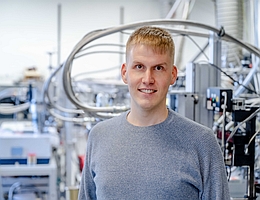The research group wants to bring the conditions from space to Earth and thus gain new insights into how the building blocks of life were created. A press release from the Ruhr University Bochum (RUB).
Source: Ruhr University Bochum (RUB) December 13, 2023.

December 13, 2023 – A team from the Chair of Organic Chemistry II at the Ruhr University Bochum would like to research exactly how chemical processes in ice mixtures contributed to life being able to emerge on Earth. The German Research Foundation supports the work of Dr. André Eckhardt as part of an Emmy Noether young talent group with around 1.5 million euros for six years. “The James Webb Space Telescope makes it possible to take a detailed look at the ice chemistry of small dust particles in space,” says Eckhardt. “We want to recreate the conditions in space in the laboratory in order to better understand the chemical processes involved in the formation of new interstellar molecules.”
The project entitled “Reactivity and spectroscopic characterization of interstellar
relevant imine species” starts at the beginning of 2024.
Recreate harsh space conditions in the laboratory
Eckhardt’s team will produce interstellar ice mixtures at low temperatures and in high vacuum. The researchers irradiate the mixtures with electrons in order to imitate the high-energy cosmic radiation from space. “These harsh conditions mean that chemical bonds can be broken very easily. Small, simple building blocks can easily form larger, more complex molecules, which scientists like to view as the building blocks of life,” says Eckhardt.
In a new experiment, highly reactive species, which arise immediately after chemical bonds are broken, are to be detected directly in the ice. Typically, these very reactive molecules continue to react immediately and can only be detected indirectly using the newly formed products. “With our experiment we want to detect these previously unknown reactive intermediates directly in the ice in order to be able to make statements about new astrochemical reaction mechanisms,” says Eckhardt.
The focus of research is primarily on reactive nitrogen compounds. They could serve as building blocks for the amino acids that exist today and are essential for life on Earth.
In addition to the organic synthesis of starting compounds and products, the methods include various spectroscopic techniques and quantum mechanical calculations.
